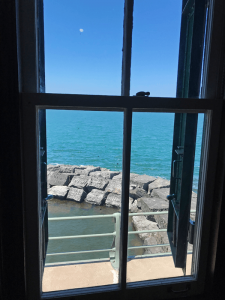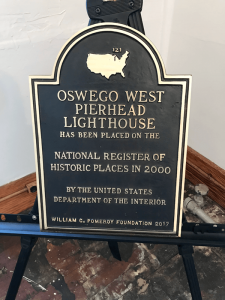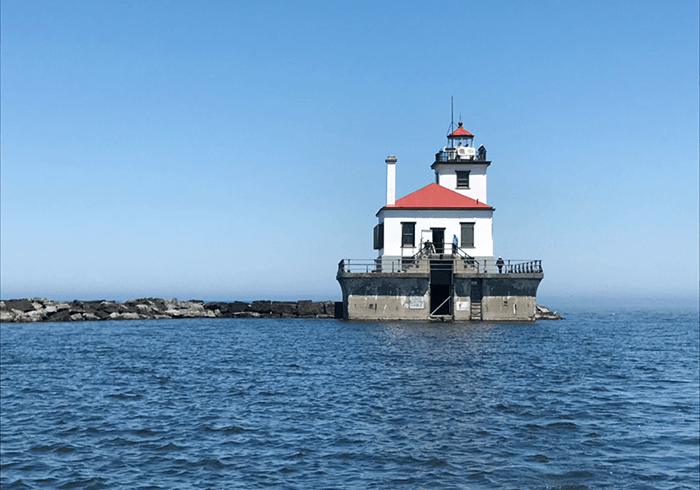Oswego West Pierhead Lighthouse now open for boat tours
By Mary Beth Roach

As a deckhand with the H. Lee White Maritime Museum’s tours to the Oswego West Pierhead Lighthouse, I get to spend Friday afternoons on a pontoon boat on Lake Ontario — meeting people from all over the world, and sharing and learning a lot about the history of Oswego and its harbor.
The tours run on Friday and Saturday afternoons, weather permitting, through September.
My fascination with the Oswego Lighthouse dates back to the early 1980s, when I moved to the city for work.
I moved on to another city a few years later, and ultimately returned to my hometown of Syracuse.
But, my fascination continued.
Like many of you, I have seen countless photos of the structure at various times of the year. It’s probably the most photographed of all of Oswego’s buildings.
I’ve kayaked out there a few times over the years to get a close-up view. It had fallen into a state of disrepair and looked, well, tired. I never would have imagined that the lighthouse would ever be made available for public tours.
Apparently, there were many others who have had an even greater fascination with the lighthouse and had a plan.
In 2011, the Oswego Lighthouse Development Committee was formed and restoration began. The Maritime Museum acquired a lease from the city of Oswego in 2014, and tours began in 2016.
I only learned of the tours earlier this year, but when I learned that they needed volunteers, I quickly signed up.
Guests have included international students, lighthouse aficionados from Canada, visitors from throughout the state, and even a few local residents from Oswego and Fulton who listed a tour of this local iconic landmark on their “bucket list.”
While the lighthouse is the ultimate destination of the trip, there is so much for visitors to see and learn about as we pull out into the harbor.
The area is such a wonderful blend of history and commerce. Perhaps the harbor is not the bustling center it was back in the day, but still there is a lot going on.
We pass the 1927 NYS Derrick Boat 8, one of the last surviving steam-powered floating derricks to have worked on the New York State Barge Canal, and it serves as a reminder of how important steam power was in the United States.
The tugboat LT-5 saw action during the Normandy invasion in 1944, as part of Operation Mulberry.
On the boat’s stack is a “kill mark” — a white plane with a swastika in the center has been painted on to show that it had shot down a German warplane on June 9, 1944.
The Eleanor D, the last commercial fishing vessel on Lake Ontario, was made from scrap metal from World War II, and was purchased by the Cahill family, well-known fishermen in Oswego.
Their former fish market on West First Street was once the oldest commercial establishment in the city.
Bill Cahill served as Oswego’s mayor in the 1980s. And the stone building is finding new life, being restored and developed into market-rate and upscale apartments and restaurant space.
As we come into the open harbor, visitors can see the rooftops of the historic Fort Ontario, and just below the fort was the first lighthouse, built in 1822 for $3,500.
The Oswego Canal opened in 1928, linking Lake Ontario to the Erie Canal and eventually to the major harbors of New York City and Buffalo. As a result, the Oswego Harbor grew in importance, requiring a more substantial lighthouse.
When construction began on the new arrowhead breakwaters at the entrance to the harbor in 1931, a temporary light was placed on the top of the NYS Barge Canal Terminal Elevator.
A fourth lighthouse, which sits at the end of the 2,000-foot-long breakwater, was opened in 1934.
As visitors approach the lighthouse, they can get a close-up look at the breakwater.
Well fortified
Black lines run vertical in the stone, from where explosives were placed to blast them out of the earth. On the east side of the harbor are concrete pieces, called dolosse, or more informally jacks, because of their resemblance to the jacks we, of a certain age, played with as kids.
Their shapes are supposed to break up the waves under water.
It was near the breakwater area that a tragedy occurred on Friday, Dec. 4, 1942.
The commander of the Oswego Coast Guard Station, along with seven crewmembers from the station and two lighthouse keepers, set out in a boat to relieve Karl Jackson, who had been on duty since Tuesday of that week.
A winter storm had prevented the crew from relieving Jackson earlier. But that Friday, the winds had reduced substantially, and the commander felt they could reach the lighthouse safely, which they did.

The two lighthouse keepers disembarked, and Jackson came aboard. Then, disaster struck. Waves smashed the vessel against the crib breaking some of the hull’s planks and killing the engine.
The waves then carried the vessel across the harbor entrance and into the east breakwater. Two men in the front were able to break out panes of glass and climbed onto the breakwater. But the other six men were tossed into the churning waters.
The two who were able to get to the breakwater were rescued about an hour later, but the other men, including keeper Jackson, died.
According to one website, two bodies, including that of Jackson, were located the following April in Henderson Harbor, a good 30 miles from Oswego.
Once at the lighthouse, guests take a ramp from the boat to the lighthouse and enter its basement floor. Some climbing is required to reach the upper sections.
On the second floor, there’s the radio room, the kitchen and the keepers’ quarters. The third floor housed the signal room, and then a ladder will take you up to the top.
The light was converted in 1995 to a solar-powered beacon and updated in 2010.
Volunteer guides are situated on each floor to show visitors around and answer questions.
Most of the shutters and windows are open on all sides, allowing guests stunning views of the harbor, the city and the lake.
The boat ride back from the lighthouse provides better views of the city’s skyline — Bridge Street, spanning Oswego River; the steeple of St. Mary’s Church; Wright’s Landing, which can accommodate more than 220 vessels in its slips; the U.S. Coast Guard Station; Brietbeck Park; and if the wind is just right, there might be a windsurfer or two out there.
The volunteers all get manuals containing a great deal of history, But I have to admit, I have also learned so much from the other volunteers, passengers and captains.
After spending a few weeks in and around the lighthouse, my fascination hasn’t waned. If anything, it’s piqued my interest in more of its history and its people.
For those interested in learning more about this history, or better yet, if you want to volunteer or book a tour, feel free to contact the museum at 315-342-0480.
Ticket prices are $20 and include the tour and admission to the museum as well.












